Robhess OpenSIFT 源码下载:传送门
为了进一步学习SIFT,选择论文就着代码看,在VS2013、OpenCV2.4.13下新建项目,跑一跑经典之作。由于将代码和Opencv配置好后还会有些错误提示,所以下面是代码的一些改动之处。(试了下其实还是ubuntu下更方便,因为有许多参数或者命令是linux下的,当然windows下可以进行一些修改后利用)。
大前提:opencv配置好。剩下的都可以通过修改来搞定。
首先看看解压后的文件,我们只需要头文件和源文件:
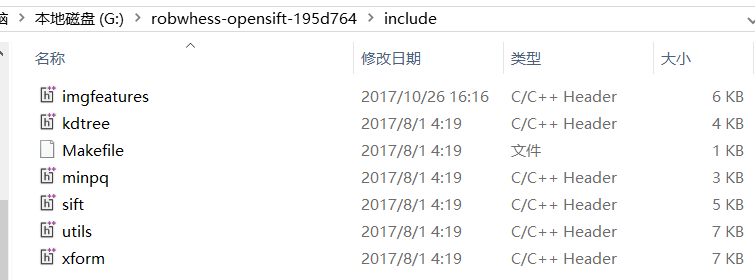

头文件:6个 源文件:10个
注意直接运行肯定不行,因为有几个文件比较特殊,下面对所有头、源文件进行解释:
1)imgfeatures.c 和 imgfeatures.h:
有SIFT特征点结构struct feature的定义,除此之外还有一些特征点的导入导出以及特征点绘制函数的声明,对应的imgfeatures.c文件中是特征点的导入导出以及特征点绘制函数的实现。
2)utils.c 和 utils.h:
这两个文件中是一些图像基本操作的函数,包括:获取某位置的像素点,设置某位置的像素点(8位,32位和64位),计算两点之间的距离的平方,在图片某一点画一个“X”,将两张图片合成为一个(在特征匹配中用到),高是二者之和,宽是二者的较大者。
3)minpq.c 和 minpq.h:
这两个文件中实现了最小优先级队列(Minimizing Priority Queue),也就是小顶堆,在k-d树的建立和搜索过程中要用到。
4)kdtree.c 和 kdtree.h:
这两个文件中实现了k-d树的建立以及用BBF(Best Bin First)算法搜索匹配点的函数。如果需要对两个图片中的特征点进行匹配,就要用到这两个文件。
5)xform.c 和 xform.h:
这两个文件中实现了RANSAC算法(RANdom SAmple Consensus 随机抽样一致)。RANSAC算法可用来筛选两个图像间的SIFT特征匹配并计算变换矩阵。可以单利用RANSAC算法筛选两个图像间的SIFT特征匹配,以得到更好的匹配结果,很经典的算法,值得学习。
6)sift.c 和 sift.h:
论文里最主要的内容在此,里面的内容就是两个特征点检测函数sift_features()和 _sift_features(),sift_features()是用默认参数进行特征点检测, _sift_features()允许用户输入各种检测参数,其实sift_features()中也是再次调用_sift_features()函数。所以只需提供原图像和存储特征点的数组以及其他一些检测参数,然后调用sift_features()或 _sift_features()就可完成SIFT特征点检测。
7)siftfeat.c :含有main函数,用来实现特征点的检测,返回特征点数目和标记特征点的图像。(主要用到)
8)match.c : 含有main函数, 检测两张图中的sift特征点,然后找到特征点的匹配对。(主要用到)
9)match_num.c : 含有main函数,检测sift特征点,但是用到了linux下的多线程编程,所以这里暂时不做讨论。
10)dspfeat.c : 含有main函数,可以从预先保存的特征点文件中读取特征点并显示在图片上。
一. 修改代码
第一步:将代码中所有头文件和源文件中的声明改一下:
修改前:
#include <cv.h> #include <cxcore.h> #include <highgui.h>
修改后:
#include <opencv/cv.h> #include <opencv/cxcore.h> #include <opencv/highgui.h>
修改原因:因为直接利用找不到opencv路径,所以调整路径。
第二步:修改源文件代码:
1. sift.c:
将函数 static IplImage*** build_gauss_pyr( IplImage* base, int octvs, int intvls, double sigma ) 中的代码进行改动:
修改前:
const int _intvls = intvls; double sig[_intvls+3], sig_total, sig_prev, k;
修改后:
const int _intvls = intvls; double *sig = (double*)malloc(sizeof(double)*(_intvls+3)); double sig_total, sig_prev, k;
...
free(sig); //子函数返回前释放内存
修改原因:
源代码中用变量_intvls+3作为数组的长度,但是VC的编译器不是GCC,它不允许这样做。DEV-C++使用的编译器是GCC,它允许使用变量作为数组的长度定义数组。
2. utils.c
首先删除这两行:
#include <gdk/gdk.h>
#include <gtk/gtk.h>
为啥删掉?
gtk是一个功能强大、设计灵活的一个通用图形库,是GNU/Linux下开发图形界面的应用程序的主流开发工具之一,GTK+也有Windows版本和Mac OS X版。在作者的源码中gtk用来调整窗口来显示图像,因为我懒于装gtk,所以直接利用opencv进行显示,所以这里需要修改一些opencv的东西。
将函数进行改动:
修改前:

1 void display_big_img( IplImage* img, char* title ) 2 { 3 IplImage* small; 4 GdkScreen* scr; 5 int scr_width, scr_height; 6 double img_aspect, scr_aspect, scale; 7 8 /* determine screen size to see if image fits on screen */ 9 gdk_init( NULL, NULL ); 10 scr = gdk_screen_get_default(); 11 scr_width = gdk_screen_get_width( scr ); 12 scr_height = gdk_screen_get_height( scr ); 13 14 if( img->width >= 0.90 * scr_width || img->height >= 0.90 * scr_height ) 15 { 16 img_aspect = (double)(img->width) / img->height; 17 scr_aspect = (double)(scr_width) / scr_height; 18 19 if( img_aspect > scr_aspect ) 20 scale = 0.90 * scr_width / img->width; 21 else 22 scale = 0.90 * scr_height / img->height; 23 24 small = cvCreateImage( cvSize( img->width * scale, img->height * scale ), 25 img->depth, img->nChannels ); 26 cvResize( img, small, CV_INTER_AREA ); 27 } 28 else 29 small = cvCloneImage( img ); 30 31 cvNamedWindow( title, 1 ); 32 cvShowImage( title, small ); 33 cvReleaseImage( &small ); 34 }
修改后:
void display_big_img(IplImage* img, char* title) { cvNamedWindow(title, 0); //参数0表示生成的窗口大小可调整,参数1表示窗口自适应图像而用户不可调整,所以我选择参数0 cvShowImage(title, img); cvReleaseImage(&img); }
3. siftfeat.c
注释掉下面一行:
#include <unistd.h>
原因:顾名思义,unistd.h是unix std的意思,是POSIX标准定义的unix类系统定义符号常量的头文件,所以在windows下先注释掉。
然后注释掉下面这两个函数:static void arg_parse( int argc, char** argv ) 和 static void usage( char* name )

1 static void arg_parse( int argc, char** argv ) 2 { 3 //extract program name from command line (remove path, if present) 4 pname = basename( argv[0] ); 5 6 //parse commandline options 7 while( 1 ) 8 { 9 char* arg_check; 10 int arg = getopt( argc, argv, OPTIONS ); 11 if( arg == -1 ) 12 break; 13 14 switch( arg ) 15 { 16 // catch unsupplied required arguments and exit 17 case ':': 18 fatal_error( "-%c option requires an argument " 19 "Try '%s -h' for help.", optopt, pname ); 20 break; 21 22 // read out_file_name 23 case 'o': 24 if( ! optarg ) 25 fatal_error( "error parsing arguments at -%c " 26 "Try '%s -h' for help.", arg, pname ); 27 out_file_name = optarg; 28 break; 29 30 // read out_img_name 31 case 'm': 32 if( ! optarg ) 33 fatal_error( "error parsing arguments at -%c " 34 "Try '%s -h' for help.", arg, pname ); 35 out_img_name = optarg; 36 break; 37 38 // read intervals 39 case 'i': 40 // ensure argument provided 41 if( ! optarg ) 42 fatal_error( "error parsing arguments at -%c " 43 "Try '%s -h' for help.", arg, pname ); 44 45 // parse argument and ensure it is an integer 46 intvls = strtol( optarg, &arg_check, 10 ); 47 if( arg_check == optarg || *arg_check != '�' ) 48 fatal_error( "-%c option requires an integer argument " 49 "Try '%s -h' for help.", arg, pname ); 50 break; 51 52 // read sigma 53 case 's' : 54 // ensure argument provided 55 if( ! optarg ) 56 fatal_error( "error parsing arguments at -%c " 57 "Try '%s -h' for help.", arg, pname ); 58 59 // parse argument and ensure it is a floating point number 60 sigma = strtod( optarg, &arg_check ); 61 if( arg_check == optarg || *arg_check != '�' ) 62 fatal_error( "-%c option requires a floating point argument " 63 "Try '%s -h' for help.", arg, pname ); 64 break; 65 66 // read contrast_thresh 67 case 'c' : 68 // ensure argument provided 69 if( ! optarg ) 70 fatal_error( "error parsing arguments at -%c " 71 "Try '%s -h' for help.", arg, pname ); 72 73 // parse argument and ensure it is a floating point number 74 contr_thr = strtod( optarg, &arg_check ); 75 if( arg_check == optarg || *arg_check != '�' ) 76 fatal_error( "-%c option requires a floating point argument " 77 "Try '%s -h' for help.", arg, pname ); 78 break; 79 80 // read curvature_thresh 81 case 'r' : 82 // ensure argument provided 83 if( ! optarg ) 84 fatal_error( "error parsing arguments at -%c " 85 "Try '%s -h' for help.", arg, pname ); 86 87 // parse argument and ensure it is a floating point number 88 curv_thr = strtol( optarg, &arg_check, 10 ); 89 if( arg_check == optarg || *arg_check != '�' ) 90 fatal_error( "-%c option requires an integer argument " 91 "Try '%s -h' for help.", arg, pname ); 92 break; 93 94 // read descr_width 95 case 'n' : 96 // ensure argument provided 97 if( ! optarg ) 98 fatal_error( "error parsing arguments at -%c " 99 "Try '%s -h' for help.", arg, pname ); 100 101 // parse argument and ensure it is a floating point number 102 descr_width = strtol( optarg, &arg_check, 10 ); 103 if( arg_check == optarg || *arg_check != '�' ) 104 fatal_error( "-%c option requires an integer argument " 105 "Try '%s -h' for help.", arg, pname ); 106 break; 107 108 // read descr_histo_bins 109 case 'b' : 110 // ensure argument provided 111 if( ! optarg ) 112 fatal_error( "error parsing arguments at -%c " 113 "Try '%s -h' for help.", arg, pname ); 114 115 // parse argument and ensure it is a floating point number 116 descr_hist_bins = strtol( optarg, &arg_check, 10 ); 117 if( arg_check == optarg || *arg_check != '�' ) 118 fatal_error( "-%c option requires an integer argument " 119 "Try '%s -h' for help.", arg, pname ); 120 break; 121 122 // read double_image 123 case 'd' : 124 img_dbl = ( img_dbl == 1 )? 0 : 1; 125 break; 126 127 // read display 128 case 'x' : 129 display = 0; 130 break; 131 132 // user asked for help 133 case 'h': 134 usage( pname ); 135 exit(0); 136 break; 137 138 // catch invalid arguments 139 default: 140 fatal_error( "-%c: invalid option. Try '%s -h' for help.", 141 optopt, pname ); 142 } 143 } 144 145 // make sure an input file is specified 146 if( argc - optind < 1 ) 147 fatal_error( "no input file specified. Try '%s -h' for help.", pname ); 148 149 // make sure there aren't too many arguments 150 if( argc - optind > 1 ) 151 fatal_error( "too many arguments. Try '%s -h' for help.", pname ); 152 153 // copy image file name from command line argument 154 img_file_name = argv[optind]; 155 }

1 static void usage( char* name ) 2 { 3 fprintf(stderr, "%s: detect SIFT keypoints in an image ", name); 4 fprintf(stderr, "Usage: %s [options] <img_file> ", name); 5 fprintf(stderr, "Options: "); 6 fprintf(stderr, " -h Display this message and exit "); 7 fprintf(stderr, " -o <out_file> Output keypoints to text file "); 8 fprintf(stderr, " -m <out_img> Output keypoint image file (format" 9 " determined by extension) "); 10 fprintf(stderr, " -i <intervals> Set number of sampled intervals per" 11 " octave in scale space "); 12 fprintf(stderr, " pyramid (default %d) ", 13 SIFT_INTVLS); 14 fprintf(stderr, " -s <sigma> Set sigma for initial gaussian" 15 " smoothing at each octave "); 16 fprintf(stderr, " (default %06.4f) ", SIFT_SIGMA); 17 fprintf(stderr, " -c <thresh> Set threshold on keypoint contrast" 18 " |D(x)| based on [0,1] "); 19 fprintf(stderr, " pixel values (default %06.4f) ", 20 SIFT_CONTR_THR); 21 fprintf(stderr, " -r <thresh> Set threshold on keypoint ratio of" 22 " principle curvatures "); 23 fprintf(stderr, " (default %d) ", SIFT_CURV_THR); 24 fprintf(stderr, " -n <width> Set width of descriptor histogram" 25 " array (default %d) ", SIFT_DESCR_WIDTH); 26 fprintf(stderr, " -b <bins> Set number of bins per histogram" 27 " in descriptor array "); 28 fprintf(stderr, " (default %d) ", SIFT_DESCR_HIST_BINS); 29 fprintf(stderr, " -d Toggle image doubling (default %s) ", 30 SIFT_IMG_DBL == 0 ? "off" : "on"); 31 fprintf(stderr, " -x Turn off keypoint display "); 32 }
注释原因:此函数是一些控制台操作,其中有许多Unix标准库提供的函数,而我们不需要。
注释掉main函数中的:
arg_parse( argc, argv );
注释原因:调用了上面那个arg_parse函数。
4. imgfeatures.c
在首行加入宏定义:
#define M_PI 3.14159265358979323846
原因:报错“M_PI”未声明。
暂时这么多,可能还有些细节问题,但是很容易解决。
二. 运行程序
好了到目前为止可以进行试验了,因为上文提到有4个main函数,所以可以分别运行来看看他们到底实现了什么功能。
1. siftfeat.c
利用siftfeat.c进行特征点的检测,返回检测到的特征点数目并在图中标记出。
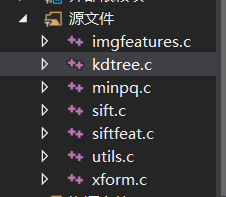

配置好的siftfeat.c文件:

1 /* 2 This program detects image features using SIFT keypoints. For more info, 3 refer to: 4 5 Lowe, D. Distinctive image features from scale-invariant keypoints. 6 International Journal of Computer Vision, 60, 2 (2004), pp.91--110. 7 8 Copyright (C) 2006-2012 Rob Hess <rob@iqengines.com> 9 10 Note: The SIFT algorithm is patented in the United States and cannot be 11 used in commercial products without a license from the University of 12 British Columbia. For more information, refer to the file LICENSE.ubc 13 that accompanied this distribution. 14 15 Version: 1.1.2-20100521 16 */ 17 18 #include "sift.h" 19 #include "imgfeatures.h" 20 #include "utils.h" 21 22 #include <opencv/highgui.h> 23 24 //#include <unistd.h> //unix 标准头文件 25 26 #define OPTIONS ":o:m:i:s:c:r:n:b:dxh" 27 28 /*************************** Function Prototypes *****************************/ 29 30 static void usage( char* ); 31 static void arg_parse( int, char** ); 32 33 /******************************** Globals ************************************/ 34 35 char* pname; 36 char* img_file_name = "G:\360downloads\pc.jpg"; //待检测图片的绝对路径 37 char* out_file_name = NULL; //导出特征点到此文件中 38 char* out_img_name = NULL; //导出图片的文件名 39 int intvls = SIFT_INTVLS; 40 double sigma = SIFT_SIGMA; 41 double contr_thr = SIFT_CONTR_THR; 42 int curv_thr = SIFT_CURV_THR; 43 int img_dbl = SIFT_IMG_DBL; 44 int descr_width = SIFT_DESCR_WIDTH; 45 int descr_hist_bins = SIFT_DESCR_HIST_BINS; 46 int display = 1; 47 48 49 /********************************** Main *************************************/ 50 51 int main( int argc, char** argv ) 52 { 53 IplImage* img; 54 struct feature* features; 55 int n = 0; 56 57 //arg_parse( argc, argv ); 58 59 fprintf( stderr, "Finding SIFT features... " ); 60 img = cvLoadImage( img_file_name, 1 ); 61 if( ! img ) 62 fatal_error( "unable to load image from %s", img_file_name ); 63 n = _sift_features( img, &features, intvls, sigma, contr_thr, curv_thr, 64 img_dbl, descr_width, descr_hist_bins ); 65 fprintf( stderr, "Found %d features. ", n ); 66 67 if( display ) 68 { 69 draw_features( img, features, n ); 70 display_big_img( img, img_file_name ); 71 cvWaitKey( 0 ); 72 } 73 74 if( out_file_name != NULL ) 75 export_features( out_file_name, features, n ); 76 77 if( out_img_name != NULL ) 78 cvSaveImage( out_img_name, img, NULL ); 79 return 0; 80 }
直接运行得到结果:


输入图像 输出图像

可以看到找到了3001个特征点。
2. match.c
注意这次调用match中的main函数,所以暂时将siftfeat.c移除。

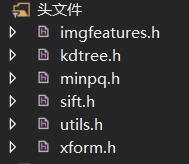
配置好的match.c文件:

1 /* 2 Detects SIFT features in two images and finds matches between them. 3 4 Copyright (C) 2006-2012 Rob Hess <rob@iqengines.com> 5 6 @version 1.1.2-20100521 7 */ 8 9 #include "sift.h" 10 #include "imgfeatures.h" 11 #include "kdtree.h" 12 #include "utils.h" 13 #include "xform.h" 14 15 #include <opencv/cv.h> 16 #include <opencv/cxcore.h> 17 #include <opencv/highgui.h> 18 19 #include <stdio.h> 20 21 22 /* the maximum number of keypoint NN candidates to check during BBF search */ 23 #define KDTREE_BBF_MAX_NN_CHKS 200 24 25 /* threshold on squared ratio of distances between NN and 2nd NN */ 26 #define NN_SQ_DIST_RATIO_THR 0.49 27 28 29 int main( int argc, char** argv ) 30 { 31 IplImage* img1, * img2, * stacked; 32 struct feature* feat1, * feat2, * feat; 33 struct feature** nbrs; 34 struct kd_node* kd_root; 35 CvPoint pt1, pt2; 36 double d0, d1; 37 int n1, n2, k, i, m = 0; 38 39 if( argc != 3 ) 40 fatal_error( "usage: %s <img1> <img2>", argv[0] ); 41 42 img1 = cvLoadImage( argv[1], 1 ); 43 if( ! img1 ) 44 fatal_error( "unable to load image from %s", argv[1] ); 45 img2 = cvLoadImage( argv[2], 1 ); 46 if( ! img2 ) 47 fatal_error( "unable to load image from %s", argv[2] ); 48 stacked = stack_imgs( img1, img2 ); 49 50 fprintf( stderr, "Finding features in %s... ", argv[1] ); 51 n1 = sift_features( img1, &feat1 ); 52 fprintf( stderr, "Finding features in %s... ", argv[2] ); 53 n2 = sift_features( img2, &feat2 ); 54 fprintf( stderr, "Building kd tree... " ); 55 kd_root = kdtree_build( feat2, n2 ); 56 for( i = 0; i < n1; i++ ) 57 { 58 feat = feat1 + i; 59 k = kdtree_bbf_knn( kd_root, feat, 2, &nbrs, KDTREE_BBF_MAX_NN_CHKS ); 60 if( k == 2 ) 61 { 62 d0 = descr_dist_sq( feat, nbrs[0] ); 63 d1 = descr_dist_sq( feat, nbrs[1] ); 64 if( d0 < d1 * NN_SQ_DIST_RATIO_THR ) 65 { 66 pt1 = cvPoint( cvRound( feat->x ), cvRound( feat->y ) ); 67 pt2 = cvPoint( cvRound( nbrs[0]->x ), cvRound( nbrs[0]->y ) ); 68 pt2.y += img1->height; 69 cvLine( stacked, pt1, pt2, CV_RGB(255,0,255), 1, 8, 0 ); 70 m++; 71 feat1[i].fwd_match = nbrs[0]; 72 } 73 } 74 free( nbrs ); 75 } 76 77 fprintf( stderr, "Found %d total matches ", m ); 78 display_big_img( stacked, "Matches" ); 79 cvWaitKey( 0 ); 80 81 /* 82 UNCOMMENT BELOW TO SEE HOW RANSAC FUNCTION WORKS 83 84 Note that this line above: 85 86 feat1[i].fwd_match = nbrs[0]; 87 88 is important for the RANSAC function to work. 89 */ 90 /* 91 { 92 CvMat* H; 93 IplImage* xformed; 94 H = ransac_xform( feat1, n1, FEATURE_FWD_MATCH, lsq_homog, 4, 0.01, 95 homog_xfer_err, 3.0, NULL, NULL ); 96 if( H ) 97 { 98 xformed = cvCreateImage( cvGetSize( img2 ), IPL_DEPTH_8U, 3 ); 99 cvWarpPerspective( img1, xformed, H, 100 CV_INTER_LINEAR + CV_WARP_FILL_OUTLIERS, 101 cvScalarAll( 0 ) ); 102 cvNamedWindow( "Xformed", 1 ); 103 cvShowImage( "Xformed", xformed ); 104 cvWaitKey( 0 ); 105 cvReleaseImage( &xformed ); 106 cvReleaseMat( &H ); 107 } 108 } 109 */ 110 111 cvReleaseImage( &stacked ); 112 cvReleaseImage( &img1 ); 113 cvReleaseImage( &img2 ); 114 kdtree_release( kd_root ); 115 free( feat1 ); 116 free( feat2 ); 117 return 0; 118 }
注意运行此程序的方法,以及图片的存放路径,具体步骤见博客。
例如我的两张图片为:pc1.jpg 和 pc2.jpg,此外我都是在debug形式下调试,所以不要搞错为release。



pc1.jpg pc2.jpg
直接运行结果:
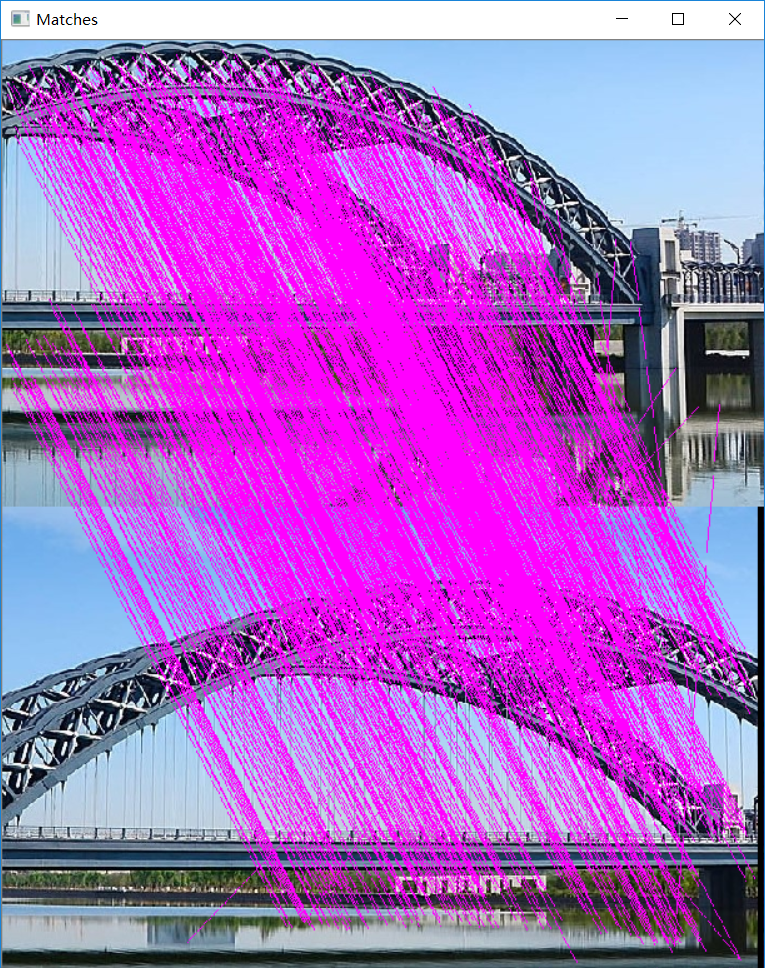
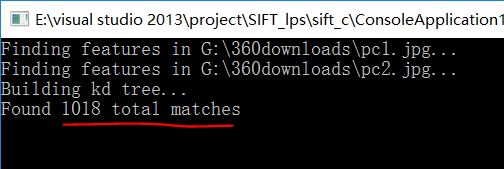
可以看到总共找出1018对匹配点对。
此外其实注意到在match.c中的main函数有一部分代码被注释掉了,而这段代码调用了xform.c,即(RANSAC算法(RANdom SAmple Consensus 随机抽样一致))的结果,所以将这部分代码取消注释后,直接执行:

/* Detects SIFT features in two images and finds matches between them. Copyright (C) 2006-2012 Rob Hess <rob@iqengines.com> @version 1.1.2-20100521 */ #include "sift.h" #include "imgfeatures.h" #include "kdtree.h" #include "utils.h" #include "xform.h" #include <opencv/cv.h> #include <opencv/cxcore.h> #include <opencv/highgui.h> #include <stdio.h> /* the maximum number of keypoint NN candidates to check during BBF search */ #define KDTREE_BBF_MAX_NN_CHKS 200 /* threshold on squared ratio of distances between NN and 2nd NN */ #define NN_SQ_DIST_RATIO_THR 0.49 int main( int argc, char** argv ) { IplImage* img1, * img2, * stacked; struct feature* feat1, * feat2, * feat; struct feature** nbrs; struct kd_node* kd_root; CvPoint pt1, pt2; double d0, d1; int n1, n2, k, i, m = 0; if( argc != 3 ) fatal_error( "usage: %s <img1> <img2>", argv[0] ); img1 = cvLoadImage( argv[1], 1 ); if( ! img1 ) fatal_error( "unable to load image from %s", argv[1] ); img2 = cvLoadImage( argv[2], 1 ); if( ! img2 ) fatal_error( "unable to load image from %s", argv[2] ); stacked = stack_imgs( img1, img2 ); fprintf( stderr, "Finding features in %s... ", argv[1] ); n1 = sift_features( img1, &feat1 ); fprintf( stderr, "Finding features in %s... ", argv[2] ); n2 = sift_features( img2, &feat2 ); fprintf( stderr, "Building kd tree... " ); kd_root = kdtree_build( feat2, n2 ); for( i = 0; i < n1; i++ ) { feat = feat1 + i; k = kdtree_bbf_knn( kd_root, feat, 2, &nbrs, KDTREE_BBF_MAX_NN_CHKS ); if( k == 2 ) { d0 = descr_dist_sq( feat, nbrs[0] ); d1 = descr_dist_sq( feat, nbrs[1] ); if( d0 < d1 * NN_SQ_DIST_RATIO_THR ) { pt1 = cvPoint( cvRound( feat->x ), cvRound( feat->y ) ); pt2 = cvPoint( cvRound( nbrs[0]->x ), cvRound( nbrs[0]->y ) ); pt2.y += img1->height; cvLine( stacked, pt1, pt2, CV_RGB(255,0,255), 1, 8, 0 ); m++; feat1[i].fwd_match = nbrs[0]; } } free( nbrs ); } fprintf( stderr, "Found %d total matches ", m ); display_big_img( stacked, "Matches" ); cvWaitKey( 0 ); /* UNCOMMENT BELOW TO SEE HOW RANSAC FUNCTION WORKS Note that this line above: feat1[i].fwd_match = nbrs[0]; is important for the RANSAC function to work. */ { CvMat* H; IplImage* xformed; H = ransac_xform( feat1, n1, FEATURE_FWD_MATCH, lsq_homog, 4, 0.01, homog_xfer_err, 3.0, NULL, NULL ); if( H ) { xformed = cvCreateImage( cvGetSize( img2 ), IPL_DEPTH_8U, 3 ); cvWarpPerspective( img1, xformed, H, CV_INTER_LINEAR + CV_WARP_FILL_OUTLIERS, cvScalarAll( 0 ) ); cvNamedWindow( "Xformed", 1 ); cvShowImage( "Xformed", xformed ); cvWaitKey( 0 ); cvReleaseImage( &xformed ); cvReleaseMat( &H ); } } cvReleaseImage( &stacked ); cvReleaseImage( &img1 ); cvReleaseImage( &img2 ); kdtree_release( kd_root ); free( feat1 ); free( feat2 ); return 0; }

匹配结果
3. match_num.c
以下头文件用到了linux下的多线程编程:
#include <pthread.h>
Linux系统下的多线程遵循POSIX线程接口,称为pthread。编写Linux下的多线程程序,需要使用头文件pthread.h,连接时需要使用库libpthread.a。暂时不讨论。
4.dspfeat.c
以下头文件用到了linux标准库:
#include <unistd.h>
这个文件主要作用是可以从预先保存的特征点文件中读取特征点并显示在图片上。暂时用不到不做讨论。
源码中除了论文中步骤的实现以外,还有kdtree以及ransac等经典算法值得一看,先挖个坑,待填。
综上,可以利用sift源码来实现图像匹配,其实还可以用来作目标识别、全景图像拼接、视频跟踪等等。
附上我改好的源码链接,可以参考此文,直接运行: sift_c
参考:
